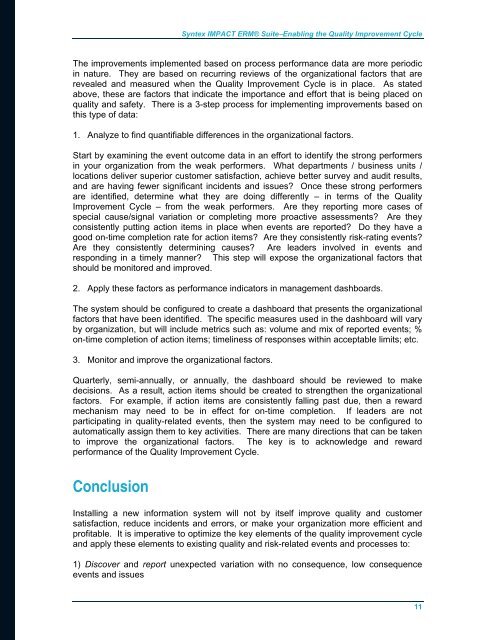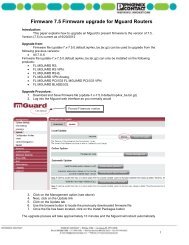Improving Quality While Managing Risk-Related ... - ISSSource
Improving Quality While Managing Risk-Related ... - ISSSource
Improving Quality While Managing Risk-Related ... - ISSSource
Create successful ePaper yourself
Turn your PDF publications into a flip-book with our unique Google optimized e-Paper software.
Syntex IMPACT ERM® SuiteEnabling the <strong>Quality</strong> Improvement Cycle<br />
The improvements implemented based on process performance data are more periodic<br />
in nature. They are based on recurring reviews of the organizational factors that are<br />
revealed and measured when the <strong>Quality</strong> Improvement Cycle is in place. As stated<br />
above, these are factors that indicate the importance and effort that is being placed on<br />
quality and safety. There is a 3-step process for implementing improvements based on<br />
this type of data:<br />
1. Analyze to find quantifiable differences in the organizational factors.<br />
Start by examining the event outcome data in an effort to identify the strong performers<br />
in your organization from the weak performers. What departments / business units /<br />
locations deliver superior customer satisfaction, achieve better survey and audit results,<br />
and are having fewer significant incidents and issues? Once these strong performers<br />
are identified, determine what they are doing differently – in terms of the <strong>Quality</strong><br />
Improvement Cycle – from the weak performers. Are they reporting more cases of<br />
special cause/signal variation or completing more proactive assessments? Are they<br />
consistently putting action items in place when events are reported? Do they have a<br />
good on-time completion rate for action items? Are they consistently risk-rating events?<br />
Are they consistently determining causes? Are leaders involved in events and<br />
responding in a timely manner? This step will expose the organizational factors that<br />
should be monitored and improved.<br />
2. Apply these factors as performance indicators in management dashboards.<br />
The system should be configured to create a dashboard that presents the organizational<br />
factors that have been identified. The specific measures used in the dashboard will vary<br />
by organization, but will include metrics such as: volume and mix of reported events; %<br />
on-time completion of action items; timeliness of responses within acceptable limits; etc.<br />
3. Monitor and improve the organizational factors.<br />
Quarterly, semi-annually, or annually, the dashboard should be reviewed to make<br />
decisions. As a result, action items should be created to strengthen the organizational<br />
factors. For example, if action items are consistently falling past due, then a reward<br />
mechanism may need to be in effect for on-time completion. If leaders are not<br />
participating in quality-related events, then the system may need to be configured to<br />
automatically assign them to key activities. There are many directions that can be taken<br />
to improve the organizational factors. The key is to acknowledge and reward<br />
performance of the <strong>Quality</strong> Improvement Cycle.<br />
Conclusion<br />
Installing a new information system will not by itself improve quality and customer<br />
satisfaction, reduce incidents and errors, or make your organization more efficient and<br />
profitable. It is imperative to optimize the key elements of the quality improvement cycle<br />
and apply these elements to existing quality and risk-related events and processes to:<br />
1) Discover and report unexpected variation with no consequence, low consequence<br />
events and issues<br />
11




